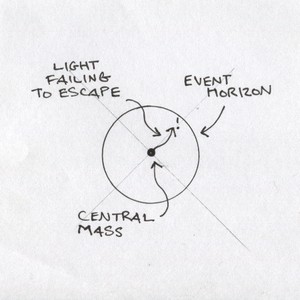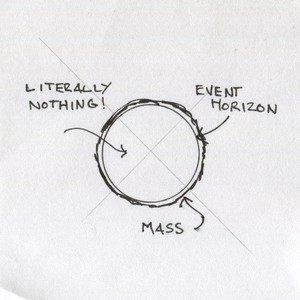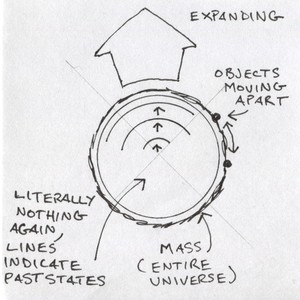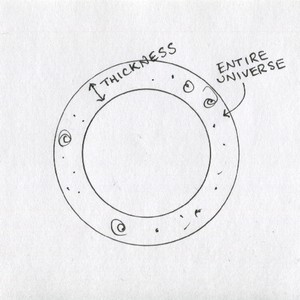|
|
A Shell Universe: Black Holes And The Big Bang
I had an insight about the universe and its expansion, even an idea about its origins, what happened before the Big Bang.
Black Holes
This stemmed from my belief, stated here before, that black holes are not what is normally considered to be a black hole. That is, not a dense core of mass, like a heavy planet or star, so dense that light cannot escape it's gravity. My problem with this idea is that if light cannot escape, then nothing can, and if nothing can escape then nothing can fall in either, as that would create a one-way sink; a pit of permanent removal from the universe.
|
|
I also don't accept that a gravitational singularity, or any infinity or point of infinity can exist in the universe; for if one infinite thing should exist, infinity would take hold and everything would become infinite; time space, light, energy, to the extent that nothing could exist except infinity. Atoms via quantum mechanics avoid this very problem elegantly by flickering between existence and non-existence at the correct rate. Any expectation of actual infinity is a flaw in any theory which should predict it, eg. General Relativity.
Stephen Hawking predicted a solution to my black hole anxieties here, at least, where Hawking Radiation emits from the black hole. We will set this aside for now.
For me, if space beyond the event horizon is not accessible, then it does not exist, it is simply a convex boundary to our space. Upon formation, all of the mass of a black hole is pushed outwards to just beyond its event horizon, and it remains there like a shell. The centre of gravity would remain central. From the perspective of this shell, it is a point that happens to be quite large; it has nothing 'behind it'. The hole of the black hole is literally nothing, and an object falling towards it would be absorbed, crushed, deflected into the shell and never further.
|
|
I thought about the growth and shrinkage of this shell. I wondered how this might relate to the universe itself. What if the universe itself was a shell like this, expanding from a collapsed black hole?
Another dimension would be required, the universe would be shell shaped, objects on the surface of a sphere. Objects would move apart as the sphere expanded. One difference between this model and the conventional view is that looking far enough away, we would see our backs, akin to travelling around the surface of the Earth.
|
|
The relation of this to the origin of the Big Bang is that a collapsing black hole as big as the entire universe may cause this expansion. Being a collapsed real object, a former universe, perhaps in the style Roger Penrose conceived, would have pseudo-random elements, not be perfectly symmetrical. Different forces would be at play at different sizes, as they are for the boiling matter of stellar objects.
In terms of expansion, objects would move apart at the same relative rates, that is, if the universe doubled in expansion by either method, objects would be twice as far apart. What differences might we detect in a shell-universe?
First, the ultimate origin of the expansion force, and the force of gravitational attraction which applies to the whole universe to counteract the expansion would have a different origin, not in the universe itself but at the heart of the 'null sphere'. This would mean that distant parts of the universe would be able to communicate gravitationally faster than they would normally appear to be able to, across the sphere rather than only around the sphere's circumference. Thus the speed of light may appear to be faster; specifically and at most the difference between the diameter and half a circumference, that is pi/2-1, or 57.0796% faster, at most 470,912,891 m/s.
Second, there may be a thickness to the shell-universe. It can't be infinitely thin, there can be no-more zero than infinity. It may be as thin as thin can be, the thickness of a Planck-length, or it may be thicker, cosmological. If thick, then how may this manifest itself? Some parts of the universe would appear to be expanding faster than others because the 'outer' objects would expand faster than the 'inner' ones. The speed differences can be predicted based on the 'thickness' of this shell. The objects on the outer edge would be moving faster than those on the inner, so the thickness would increase over time; this would be necessary because there would be more surface area on the outer edge to make up. We would see objects in one plane (sideways, along the circumference) distorted compared to looking at the slightly older objects in the lower, smaller edge.
|
|
Mark Sheeky, 11 February 2025
|
|

 Books
Books
 Poetry/Lyrics
Poetry/Lyrics
 Essays
Essays



